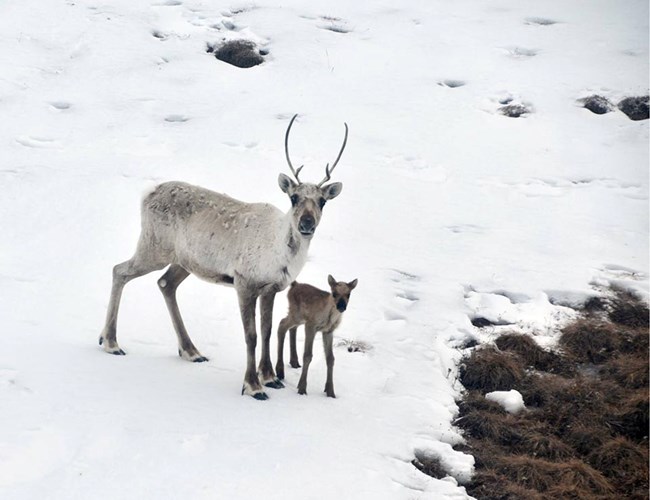Last updated: April 10, 2018
Article
The Importance of Minerals in Caribou Forage

NPS/Matt Cameron
Replenishing depleted mineral stores may affect the distribution and migrations of northern caribou herds after the long Arctic winter. A study with our collaborators investigated the timing, availability, and relationships of minerals in summer forages (willows, grasses, and forbs) for the Central Arctic and Western Arctic caribou herds in northern Alaska. Scientists found that mineral abundance across the landscape was tied to soil pH and mineral content, while mineral availability was related to plant (forage) maturity. Concentrations of sodium were below caribou requirements in all forage species for most of the summer and adequate only on the Arctic Coastal Plain during the second half of summer. Thus, mineral content and availability may influence where northern caribou spend their brief summer months.
Mineral constraints on arctic caribou (Rangifer tarandus): a spatial and phenological perspective
Abstract
Arctic caribou (Rangifer tarandus) have the longest terrestrial migration of any ungulate but little is known about the spatial and seasonal variation of minerals in summer forages and the potential impacts of mineral nutrition on the foraging behavior and nutritional condition of arctic caribou. We investigated the phenology, availability, and mechanistic relationships of calcium, phosphorus, magnesium, sodium, potassium, iron, manganese, copper, and zinc in three species of woody browse, three species of graminoids, and one forb preferred by caribou over two transects bisecting the ranges of the Central Arctic (CAH) and Western Arctic (WAH) caribou herds in Alaska. Transects traversed three ecoregions (Coastal Plain, Arctic Foothills and Brooks Range) along known migration paths in the summer ranges of both herds. Concentrations of mineral in forages were compared to estimated dietary requirements of lactating female caribou. Spatial distribution of the abundance of minerals in caribou forage was associated with interactions of soil pH and mineral content, while temporal variation was related to plant maturity, and thus nitrogen and fiber content of forages. Concentrations of sodium were below caribou requirements in all forage species for most of the summer and adequate only on the Coastal Plain during the second half of summer. Phosphorus declined in plants from emergence to senescence and was below requirements in all forages by mid‐summer, while concentrations of copper declined to marginal concentrations at plant senescence. Interactions of sodium with potassium, calcium with phosphorus, and copper with zinc in forages likely exacerbate the constraints of low concentrations sodium, phosphorus, and copper. Forages on the WAH contained significantly more phosphorus and copper than forages collected on the CAH transect. We suspect that migrations of caribou to the Arctic Coastal Plain may allow parturient females to replenish sodium stores depleted by foraging inland through the long arctic winters, while also extending the availability of adequate phosphorus, if animals are able to selectively track emerging waves of forage.
Oster, K. W., P. S. Barboza, D. D. Gustine, K. Joly, and R. D. Shively. 2018. Mineral constraints on arctic caribou (Rangifer tarandus): A spatial and phenological perspective. Ecosphere 9(3):e02160.
